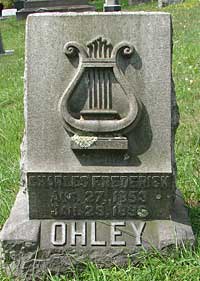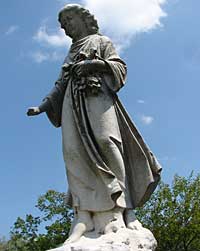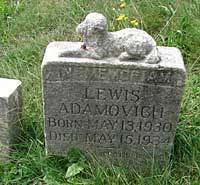.

A simple marker for George Albert Dunnington, 1858-1900

An elaborate carving of Madonna or Easter lilies on a Fleming family art nouveau monument. Lilies were a symbol of purity.

A early 20th C Neo-Classic monument (note pediment cap with laurel leaves) on Binn Family marker. Laurel wreaths often represent eternity or immortality as laurel leaves do not wilt or fade. They are also a symbol of victory.
|
Grave Monuments and Markers
We generally use the terms headstone, tombstone, grave marker and gravestone are used synonymously. It wasn't always that way and even today there are distinctions. The terms tombstone and headstone were originally used to describe the stone lid of a coffin, while a ‘gravestone’ was the marker that was placed on top of the gravesite. It was not until after many years that granite, largely due to durability and improved methods of carving, became the most popular choice for headstones (now also known as tombstones, markers, gravestones, monuments, memorials). Marble tends to deteriorate as does slate and sandstone. Wooden headstones were briefly popular in the 19th century, but these disappear quickly.
For centuries, grave markers have been artistic symbols of remembrance and cemeteries today are similar to outdoor sculpture gardens. They are also "places where friends and relatives can mourn openly, and feel close to the deceased. Grave markers are important repositories of geneaological and historical information. They traditionally bear the deceased’s name, the years of birth and death, an inscription and, possibly, an emblem or symbol. Inscriptions, or epitaphs, are usually personalized to honor the deceased’s life, or may quote a religious text. The emblem selected for headstone is usually a symbolic image that represents hope, faith, wisdom, glory, purity, love, life, victory, etc."
Styles continue to evolve. Many monuments are again fairly simple today, but Woodlawn Cemetery contains some extraordinarily interesting, extravagant or ornate memorials. A stroll through Woodlawn can be both an artistically and historically enlightening experience. The images on this page are only a few of the wide range of monument decoration and style you will see when exploring this beautiful park.

These lovingly decorated monuments are remarkable simply for personal ornamentation added by family. They are clear testimony of the love and remembrance of relatives who visit regularly. Notice the eternal flame placed in front of the foreground monument.
|
 Mid-19th C Ohley Family marker with popular classical lyre motif. Lyres are a more playful instrument than harps but still associated with heavenly aspirations. Mid-19th C Ohley Family marker with popular classical lyre motif. Lyres are a more playful instrument than harps but still associated with heavenly aspirations.

One of our "angels," actual a depiction of an idealized young woman. Perhaps this sculpture is meant to represent one of the seven virtues---female figures which are normally represented without wings.

Lambs are generally found on the monument of deceased children, "lambs of God." This young boy, Lewis Adamovich died at four years.
|


